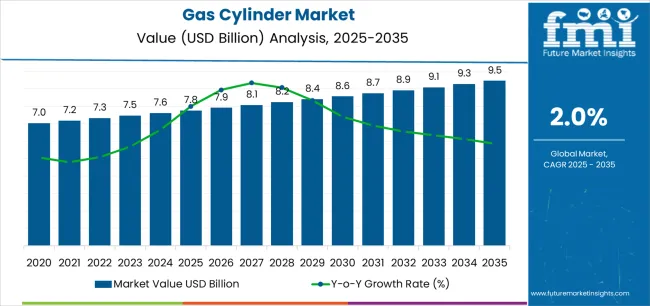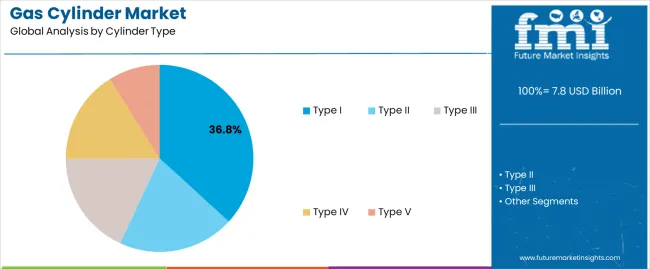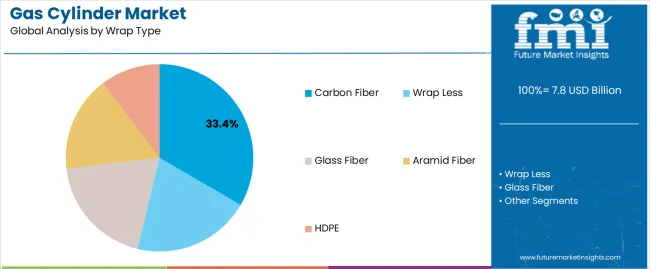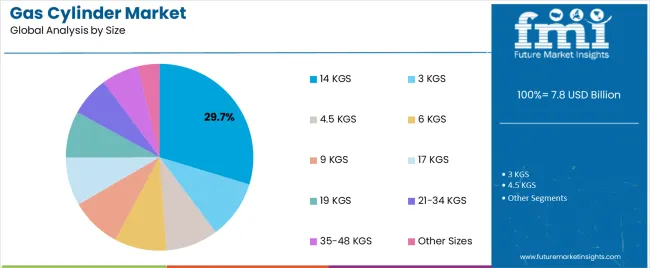The Gas Cylinder Market is estimated to be valued at USD 7.8 billion in 2025 and is projected to reach USD 9.5 billion by 2035, registering a compound annual growth rate (CAGR) of 2.0% over the forecast period.
The gas cylinder market is witnessing steady expansion driven by increasing industrial gas consumption, rising adoption in residential and commercial sectors, and growing demand from healthcare and transportation applications. The current market landscape is defined by technological advancements in cylinder design, lightweight materials, and improved safety standards that have enhanced operational efficiency and handling convenience.
Manufacturers are investing in material innovation and automation to optimize production costs while maintaining product integrity and regulatory compliance. The future outlook indicates consistent growth supported by the expansion of clean energy programs, rising demand for LPG and CNG storage solutions, and infrastructure development in emerging economies.
Market growth rationale is rooted in the transition toward high-performance composite materials, stricter safety certification requirements, and the diversification of end-use industries These trends are expected to strengthen the market’s structural stability, elevate product adoption across sectors, and sustain long-term revenue growth for global and regional producers.

| Metric | Value |
|---|---|
| Gas Cylinder Market Estimated Value in (2025 E) | USD 7.8 billion |
| Gas Cylinder Market Forecast Value in (2035 F) | USD 9.5 billion |
| Forecast CAGR (2025 to 2035) | 2.0% |
The market is segmented by Cylinder Type, Wrap Type, Size, and Gas Type and region. By Cylinder Type, the market is divided into Type I, Type II, Type III, Type IV, and Type V. In terms of Wrap Type, the market is classified into Carbon Fiber, Wrap Less, Glass Fiber, Aramid Fiber, and HDPE. Based on Size, the market is segmented into 14 KGS, 3 KGS, 4.5 KGS, 6 KGS, 9 KGS, 17 KGS, 19 KGS, 21-34 KGS, 35-48 KGS, and Other Sizes. By Gas Type, the market is divided into Inert Gases, Flammable Gases, Toxic Gases, Pyrophoric Gases, and Oxidizers. Regionally, the market is classified into North America, Latin America, Western Europe, Eastern Europe, Balkan & Baltic Countries, Russia & Belarus, Central Asia, East Asia, South Asia & Pacific, and the Middle East & Africa.

The Type I cylinder segment, holding 36.80% of the cylinder type category, has emerged as the leading product due to its robustness, cost efficiency, and extensive use across industrial and household applications. Its dominance is being maintained by established manufacturing infrastructure and proven reliability in handling high-pressure gases.
The segment benefits from low production complexity and widespread availability of steel, ensuring consistent supply and competitive pricing. Demand stability has been reinforced by replacement cycles in domestic and commercial LPG usage, while ongoing standardization of safety regulations has supported sustained adoption.
The segment continues to perform strongly in markets where cost sensitivity and durability remain primary purchase drivers Growth is expected to remain steady as industrial gas consumption increases and refurbishment of existing gas storage systems accelerates globally.

The carbon fiber segment, representing 33.40% of the wrap type category, leads the market due to its superior strength-to-weight ratio and high resistance to pressure fluctuations. The segment’s growth has been driven by increasing preference for lightweight composite cylinders in automotive, aerospace, and portable gas applications.
Enhanced safety features and extended service life have further reinforced adoption across regulated industries. Continuous advancements in resin systems and filament winding technology have enabled higher production efficiency and improved performance standards.
Demand has been supported by clean energy initiatives emphasizing CNG and hydrogen storage, where carbon fiber cylinders are preferred for efficiency and transport ease The segment is expected to maintain its leadership as manufacturers scale production capacity and invest in next-generation composite designs.

The 14 KGS segment, accounting for 29.70% of the size category, has maintained its leading position due to its optimal balance between portability and capacity, making it suitable for household, commercial, and small-scale industrial use. Its dominance has been sustained by high adoption in domestic LPG distribution systems and widespread compatibility with existing appliances.
Consistent government initiatives promoting clean cooking fuel and cylinder exchange programs have strengthened demand in developing regions. The segment also benefits from logistical efficiency and standardized refilling infrastructure that support large-scale deployment.
Market players are focusing on improving valve safety, ergonomic design, and corrosion resistance to enhance user experience and operational safety The 14 KGS size segment is expected to retain its market leadership as demand for safe, manageable, and energy-efficient fuel storage solutions continues to grow.
The scope for gas cylinder rose at a 1.2% CAGR between 2020 and 2025. The global market is anticipated to witness a CAGR of 2.1% over the forecast period 2025 to 2035.
Industrial growth, particularly in sectors such as manufacturing, healthcare, and oil and gas, had driven the demand for gas cylinders for storage and transportation of various gases used in production processes and applications, during the historical period.
Advancements in gas cylinder materials, manufacturing processes, and safety features improved the efficiency, durability, and safety of gas cylinder solutions, driving adoption across industries.
Stringent safety regulations and standards regarding the storage, handling, and transportation of gases necessitated the adoption of high quality gas cylinders compliant with international safety standards, also augmented the market growth.
The forecast period is expected to witness a significant increase in demand for gas cylinders for storing and transporting gases used in green technologies, including hydrogen fuel cells and renewable energy storage systems.
The healthcare industry is anticipated to continue driving demand for gas cylinders for the storage and transportation of medical gases, driven by the aging population, technological advancements in healthcare, and increasing healthcare infrastructure investments globally.
The proliferation of e-commerce platforms and online distribution channels is expected to streamline the procurement process for gas cylinders, making them more accessible to a wider range of customers, including small and medium sized enterprises.
The rise in industrial activities across various sectors such as manufacturing, healthcare, automotive, aerospace, and electronics is fueling the demand for gas cylinders for storage and transportation of various gases.
Stringent regulations and compliance requirements related to the manufacturing, handling, and transportation of gases and gas cylinders can pose challenges for market players. Compliance with safety standards and environmental regulations may require significant investments in technology and infrastructure.
The below table showcases revenues in terms of the top 5 leading countries, spearheaded by India and France. The countries are expected to lead the market through 2035.
| Countries | Forecast CAGRs from 2025 to 2035 |
|---|---|
| The United States | 0.7% |
| The United Kingdom | 0.8% |
| Germany | 0.5% |
| France | 1.2% |
| India | 5.4% |
The gas cylinder market in the United States expected to expand at a CAGR of 0.7% through 2035. The country has a diverse industrial base, including manufacturing, oil and gas, healthcare, aerospace, and electronics industries, all of which require gas cylinders for storage and transportation of various gases. The expansion of these industries drives the demand for gas cylinders across different applications.
The United States is a major player in the energy sector, with significant production of oil, natural gas, and renewable energy sources. Gas cylinders are essential for storing and transporting gases used in energy exploration, production, and distribution, driving demand within the energy sector.
The gas cylinder market in the United Kingdom is anticipated to expand at a CAGR of 0.8% through 2035. The healthcare sector in the United Kingdom relies on medical gases for patient care, anesthesia, respiratory therapy, and diagnostic procedures.
Gas cylinders are essential for storing and delivering medical gases such as oxygen, nitrous oxide, and carbon dioxide, supporting healthcare facilities and driving market growth in the healthcare sector.
The food and beverage industry in the United Kingdom utilizes gases for packaging, carbonation, chilling, and freezing processes. Gas cylinders provide a convenient and reliable source of gases such as carbon dioxide and nitrogen, ensuring product quality, freshness, and shelf life, thus contributing to market growth in the food and beverage sector.
Gas cylinder trends in Germany are taking a turn for the better. A 0.5% CAGR is forecast for the country from 2025 to 2035. Germany has ongoing construction and infrastructure development projects that require gases for welding, cutting, and heating applications.
Gas cylinders play a vital role in providing on site gas supply for construction sites, infrastructure projects, and maintenance activities, driving market growth in the construction sector.
Germany is undergoing a transition towards renewable energy sources and sustainable technologies. Gas cylinders are essential for storing and transporting gases used in renewable energy production, fuel cells, and hydrogen infrastructure, supporting the energy sector transition and driving market growth.
The gas cylinder market in France is poised to expand at a CAGR of 1.2% through 2035. France is known for its technological innovation and engineering expertise. Ongoing advancements in gas cylinder design, materials, and manufacturing processes enhance the safety, efficiency, and reliability of gas cylinders, driving adoption rates and market growth.
France has a growing demand for specialty gases used in research, development, and industrial applications. Gas cylinders designed for storing and delivering specialty gases enable precise control of gas compositions and purity levels, catering to the needs of laboratories, pharmaceutical companies, and semiconductor manufacturers.
The gas cylinder market in India is anticipated to expand at a CAGR of 5.4% through 2035. The focus of Indian government on reducing air pollution and promoting sustainable development has LED to a shift towards cleaner energy sources such as natural gas and LPG. Gas cylinders enable the use of these cleaner fuels in households, industries, and transportation, supporting energy transition and driving market growth in India.
Investments in gas infrastructure, including LPG bottling plants, distribution networks, and storage facilities, enhance the availability and accessibility of LPG cylinders across India. Infrastructure development projects facilitate the efficient distribution and supply of gas cylinders, fostering market expansion and meeting growing demand.
The below table highlights how Type I segment is projected to lead the market in terms of cylinder type, and is expected to account for a share of 37.3% in 2025. Based on gas type, the flammable gases segment is expected to account for a share of 29.2% in 2025.
| Category | Market Shares in 2025 |
|---|---|
| Type I | 37.3% |
| Flammable Gases | 29.2% |
Based on cylinder type, the Type I segment is expected to continue dominating the gas cylinder market. Type I gas cylinders are known for their exceptional durability and strength, making them suitable for storing and transporting various gases, including medical gases. Their robust construction ensures reliable performance and long service life, making them preferred choices in critical applications such as healthcare.
Type I cylinders are designed and manufactured to meet stringent safety standards and regulatory requirements for gas storage and transportation. Their robust construction and reliable sealing mechanisms ensure the safe containment of medical gases, reducing the risk of leaks or accidents in healthcare facilities.
In terms of gas type, the flammable gases segment is expected to continue dominating the gas cylinder market, attributed to several key factors. Flammable gases, including hydrogen, acetylene, and methane, are widely used in industrial processes such as welding, cutting, brazing, and heat treatment.
The growing demand for these gases in manufacturing, construction, automotive, and metal fabrication industries drives the growth of the flammable gases segment.
Flammable gases such as hydrogen are gaining traction as alternative energy sources for fuel cells, power generation, and energy storage systems. The increasing emphasis on renewable energy and clean technologies fuels demand for flammable gases, supporting market growth in the segment.
The competitive landscape of the gas cylinder market is characterized by a diverse mix of global, regional, and local players competing across various segments and geographical regions.
The market attracts a wide range of manufacturers, suppliers, distributors, and service providers vying for market share and differentiation, as the demand for gas cylinders spans multiple industries, including industrial, healthcare, automotive, construction, and energy.
Company Portfolio
| Attribute | Details |
|---|---|
| Estimated Market Size in 2025 | USD 7.6 billion |
| Projected Market Valuation in 2035 | USD 9.4 billion |
| Value-based CAGR 2025 to 2035 | 2.1% |
| Forecast Period | 2025 to 2035 |
| Historical Data Available for | 2020 to 2025 |
| Market Analysis | Value in USD billion |
| Key Regions Covered | North America; Latin America; Western Europe; Eastern Europe; South Asia and Pacific; East Asia; The Middle East & Africa |
| Key Market Segments Covered | Cylinder Type, Wrap Type, Size, Gas Type, Region |
| Key Countries Profiled | The United States, Canada, Brazil, Mexico, Germany, France, France, Spain, Italy, Russia, Poland, Czech Republic, Romania, India, Bangladesh, Australia, New Zealand, China, Japan, South Korea, GCC countries, South Africa, Israel |
| Key Companies Profiled | Luxfer Gas Cylinders; Hexagon Composites ASA; Worthington Cylinders; Dragerwerk AG & Co KGaA; Time Technoplast; Faber Industries P.A.; Beijing Tianhai Industry Co; Linde plc; Welz Gas Cylinder GmbH; Zhejiang Tianlong Cylinder Co. Ltd. |
The global gas cylinder market is estimated to be valued at USD 7.8 billion in 2025.
The market size for the gas cylinder market is projected to reach USD 9.5 billion by 2035.
The gas cylinder market is expected to grow at a 2.0% CAGR between 2025 and 2035.
The key product types in gas cylinder market are type i, type ii, type iii, type iv and type v.
In terms of wrap type, carbon fiber segment to command 33.4% share in the gas cylinder market in 2025.






Full Research Suite comprises of:
Market outlook & trends analysis
Interviews & case studies
Strategic recommendations
Vendor profiles & capabilities analysis
5-year forecasts
8 regions and 60+ country-level data splits
Market segment data splits
12 months of continuous data updates
DELIVERED AS:
PDF EXCEL ONLINE
Medical Gas Cylinders Market
Automotive Gas Cylinder Market Growth - Trends & Forecast 2025 to 2035
Gas & Dual-Fuel Injection Systems Market Size and Share Forecast Outlook 2025 to 2035
Gas Desiccant Dehydration Unit Market Size and Share Forecast Outlook 2025 to 2035
Gasket and Seal Market Size and Share Forecast Outlook 2025 to 2035
Gas Separation Membrane Market Size and Share Forecast Outlook 2025 to 2035
Gas Jet Compressor Market Size and Share Forecast Outlook 2025 to 2035
Gas Fired Water-Tube Food Processing Boiler Market Size and Share Forecast Outlook 2025 to 2035
Gas Fired Real Estate Generator Market Size and Share Forecast Outlook 2025 to 2035
Gastric-soluble Hollow Capsules Market Size and Share Forecast Outlook 2025 to 2035
Gas Cooling System Market Analysis - Size, Share, and Forecast Outlook 2025 to 2035
Gasoline Gensets Market Size and Share Forecast Outlook 2025 to 2035
Gas Insulated Smart Ring Main Unit Market Size and Share Forecast Outlook 2025 to 2035
Gas Turbine Oil Market Size and Share Forecast Outlook 2025 to 2035
Gas Telecom Generator Market Size and Share Forecast Outlook 2025 to 2035
Gas Insulated Ring Main Unit Market Size and Share Forecast Outlook 2025 to 2035
Gas Fired Condensing Low Temperature Commercial Boiler Market Size and Share Forecast Outlook 2025 to 2035
Gas Insulated Medium Voltage Switchgear Market Size and Share Forecast Outlook 2025 to 2035
Gas Commercial Deep Fryers Market Size and Share Forecast Outlook 2025 to 2035
Gastroesophageal Reflux Disease (GERD) Device Market Analysis - Size, Share, and Forecast Outlook 2025 to 2035

Thank you!
You will receive an email from our Business Development Manager. Please be sure to check your SPAM/JUNK folder too.
Chat With
MaRIA